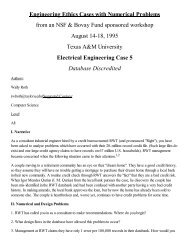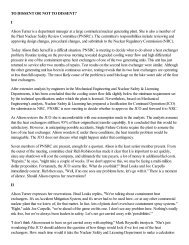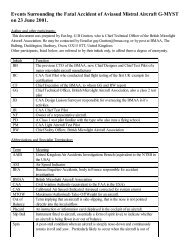ENGINEERING ETHICS - Texas A&M University
ENGINEERING ETHICS - Texas A&M University
ENGINEERING ETHICS - Texas A&M University
You also want an ePaper? Increase the reach of your titles
YUMPU automatically turns print PDFs into web optimized ePapers that Google loves.
<strong>ENGINEERING</strong> <strong>ETHICS</strong>Introducing Ethics Case Studies Into Required Undergraduate Engineering CoursesDepartment of Philosophy and Department of Mechanical Engineering<strong>Texas</strong> A&M <strong>University</strong>NSF Grant Number DIR-9012252Engineering Ethics: The Professional ChallengeEngineering ethics is attracting increasing interest in colleges of engineering throughout the nation. At <strong>Texas</strong> A&M<strong>University</strong>, evidence of this interest in professional ethics culminated in the creation of a new course in engineeringethics, as well as a project funded by the National Science Foundation to develop material for introducing ethicalissues into required undergraduate engineering courses. A small group of faculty and administrators activelysupported the growing effort at <strong>Texas</strong> A&M, yet this small group must now expand to meet the needs ofincreasing numbers of students wishing to learn more about the value implications of their actions as professionalengineers.The increasing concern for the value dimension of engineering is, at least in part, a result of the attention that themedia has given to cases such as the Challenger disaster, the Kansas City Hyatt-Regency Hotel walkwayscollapse, and the Exxon oil spill. As a response to this concern, a new discipline, engineering ethics, is emerging.This discipline will doubtless take its place alongside such well-established fields as medical ethics, businessethics, and legal ethics. The problem presented by this development is that most engineering professors are notprepared to introduce literature in engineering ethics into their classrooms. They are most comfortable withquantitative concepts and often do not believe they are qualified to lead class discussions on ethics. Manyengineering faculty members do not think that they have the time in an already overcrowded syllabus to introducediscussions on professional ethics, or the time in their own schedules to prepare the necessary material.In the fall of 1990, <strong>Texas</strong> A&M received funding from the National Science Foundation to address theseproblems. The NSF-funded research project, "Introducing Ethics Case Studies Into Required EngineeringUndergraduate Courses," was completed in August 1992. During the course of the project the co-principalinvestigators at <strong>Texas</strong> A&M, Professor Michael J. Rabins in the Department of Mechanical Engineering andProfessor Ed Harris in the Department of Philosophy, developed and tested eleven student handouts andinstructor's guides in eleven different courses in the agricultural, chemical, civil and mechanical engineeringdepartments at <strong>Texas</strong> A&M. The principal investigators were pleased by the willingness of engineeringprofessors to use the material developed during the two-year project. After observing presentation of thematerial on one or two occasions, many of the instructors were willing to present the material on their own.Student responses to the curriculum additions was overwhelmingly positive, and student and instructorevaluations suggested that there is a growing need to share this work with other engineering professors andprofessionals and to encourage more engineering instructors to present issues in professional ethics to theirclasses.<strong>Texas</strong> A&M is making the results of the NSF project's research and development available to instructors whowant to introduce ethical issues to engineering students and professionals. Eleven case studies (listed on the nextpage, along with appropriate classes into which the case can be introduced), including instructor's guides, studenthandouts and overhead transparencies, are now available in hard copy, as well as in floppy disk format for IBM
compatible users or in an ASCII format if requested on either a 5.25" or 3.5" disk. Case study summaries areprovided prior to the listing. In addition, nine background pedagogical essays are provided on the followingtopics: Moral Concepts and Theories; Basic Concepts and Methods in Ethics; Ethics and Professionalism inEngineering; Organizational Loyalty and Professional Rights; Engineers and the Environment; Risk and theEngineering Decision-Making Process; Negligence and the Professional "Debate" over Responsibility for Design;Literature on Whistle blowing - An Overview; and Engineering Design: Literature on Social ResponsibilityVersus Legal Liability.The entire output of this NSF-funded study is available in the form of a final report to the NSF.For more information on the NSF project, contact Dr. Michael J. Rabins, Department of MechanicalEngineering, <strong>Texas</strong> A&M <strong>University</strong>, College Station, <strong>Texas</strong>, 77843-3123; Telephone (409)845-1251.Floppy disks and hard copies of all cases and essays are available at cost.Case Studies In Engineering Ethics Major Engineering Thrust Ethical Issue Typical CoursesSynopses of Case StudiesThe Aberdeen Three: In 1989, three engineers working on developing chemical weapons at a U.S. Armyfacility, the Aberdeen Proving Ground in Maryland, were indicted for a criminal felony. They were tried andconvicted for illegally handling, storing and disposing of hazardous wasted in violation of the ResourceConservation and Recovery Act form 1983-1986. This case shows the importance of the engineeringprofession's social and environmental responsibilities, in both legal and moral terms. In addition, it serves as animportant case study in the escalating public concern over environmental and toxic waste, and the ways in whichgovernment is called upon to regulate engineering business. Aberdeen Three is particularly useful for students ofenvironmental engineering; however, it also is a useful case for showing engineering students their responsibility tothe public at large.Accepting Gifts and Amenities: Most engineers probably believe that accepting small favors (such asinexpensive pens) from vendors is permissible. By contrast, most engineers probably believe that accepting largegifts or amenities is wrong. Drawing the line between permissible and impermissible instances of accepting giftsand amenities is not always easy, however. This case invites students to think about the issues involved in suchdecisions. It is particularly suitable for senior-level engineering courses.American Society of Mechanical Engineers (ASME) vs. Hydrolevel Corp.: In 1971, McDonnell andMiller, an engineering firm, used an interpretation of an ASME code to undermine a boiler control devicecompetitor, Hydrolevel Corp. As a result, Hydrolevel sued McDonnell and Miller, the Hartford steam BoilerInspection and Insurance Company, and ASME on the basis of restraint of trade. In the ensuing trial, which wentall the way up to the U.S. Supreme Court, Hydrolevel's lawyers argued that two key ASME subcommitteemembers acted not only on the conflicting self-interest of their companies, but also in violation of the ShermanAnti-Trust Act. The case of ASME vs. Hydrolevel Corp. shows how easily individuals, companies, andprofessional societies can find themselves embroiled in expensive legal battles that tarnish the reputation of theengineering profession as a whole. The case is appropriate for all engineering upper-level curricula, for itdiscusses not only conflicts of interest and various engineering codes of ethics, but also illustrates the roles ofengineers within their professional societies.B.F. Goodrich Air Force A7-D Brake Problem Case: In 1969, following brake failure at June, 1968 flight
tests, and because of the ensuing accusations by a former B.F. Goodrich employee, Kermit Vandivier, regardingqualification test report falsification and ethical misconduct on the part of specific B.F. Goodrich personnel,Senator William Proxmire (D-Wisconsin) requested a governmental inquiry into the brake qualification testingperformed by B.F. Goodrich. The case is one of the most famous in the literature on whistle blowing. Yet, otherethical issues raised by the case involve engineering responsibility for failed innovation, how easy it is for eventsto escalate (in this case, to a formal Congressional hearing) when people fail to communicate and get their factsstraight, and how innovative design often makes testing procedures obsolete, or worse yet, shows that they werein fact erroneous from the onset. While valuable for all engineering students, the case is particularly well suited fordesign, materials and professionalism courses.Gilbane Gold: This case focuses on a popular videotape that depicts a hypothetical--but nonetheless realistic--account of the experiences of a young engineer who is caught between his obligations to his company, Z-CORP,and to the public. The issue at the center of the controversy has to do with the fact that Z-CORP is dischargingarsenic and lead into the city sewer system. The case is suitable for courses in environmental engineering, and incourses exploring professional issues, such as an engineer's obligations to his company and to the public.Kansas City, Missouri Hyatt Regency Hotel Walkways Collapse: As the United States' most devastatingstructural failure, in terms of loss of life and injuries, the Kansas City Hyatt Regency walkways collapse left 114dead and in excess of 200 injured. In addition, millions of dollars in costs resulted from the collapse, andthousands of lives were adversely affected, all because of disputed conversations between and engineeringdesign firm and a fabricator, and negligence on the part of the contracting engineering firm. The case provides avivid example of the importance of accuracy and detail in engineering design and shop drawings (particularlyregarding revisions), and the costly consequences of negligence in this realm. The case is particularly useful instructural design, statics and materials classes.A Plow for Mexican Peasant Farmers: Mechanical engineering students in a capstone design course areasked to design a plow that is suitable for use by peasant farmers in Mexico. The case shows how technologicalchange, especially in third-world countries, can raise value issues. It illustrates the problems created by theintersection of design considerations and these value issues, and prompts students to come up with creativesolutions to the problems. It is appropriate for design classes in mechanical engineering and is a model forprojects in capstone design courses in other branches of engineering.Space Shuttle Challenger Disaster: The fatal launching of space shuttle Challenger in 1985 resulted form ahaphazard concatenation of economic considerations, political pressures and scheduling backlogs. The reality ofa failed booster joint seal design took a back seat to these considerations, despite the protestations of designengineering Roger Boisjoly and others. Ethical issues raised by the case involve engineering responsibility versusmanagement decision-making, as well as the ethics of post-hoc whistle blowing and negligence in design. Thiscase is particularly useful to students in design, dynamics and structures courses.TV Antenna Tower Collapse: In this case, based on a real-world scenario, a television station wasvideotaping a crew raising the station's new television antenna tower. Unfortunately, on the day of videotaping,something went wrong with the lifting rig, and while the antenna was being hoisted the bolts failed. The result wasa tragedy, with seven riggers falling 1200 feet to their death. The case raises serious questions about the designengineer's social responsibility to ensure safety on a construction site where riggers hoisting the antenna tower didnot have sufficient technical expertise to know that they were endangered. Additionally, the case poses questionsabout product liability issues in engineering and ethics, particularly where knowledgeable bystanders, who could













